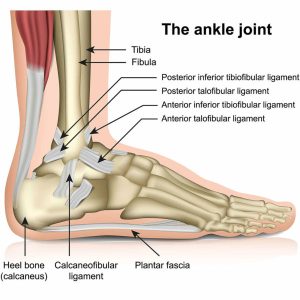Foot and Ankle Pain
How does the Foot and Ankle work?
The foot is one of the most complex, and adaptive regions of your body and is made up of 26 bones and 33 small joints.
The ankle joint has 3 bones which make up 2 joints: the true ankle joint which allows movement of the ankle up and down, and the subtalar ankle joint underneath which enables movement of the foot side to side.
Both the foot and ankle joints are supported by soft tissues made up of muscles, tendons and ligaments which provide mobility and stability, allowing our foot and ankle to adapt to all types of surfaces. The joints are covered in a cartilage which has a smooth, slippery surface allowing the ends of the bones to move against each other without friction and help with shock absorption.

Causes of Foot and Ankle Pain
Foot and ankle pain can affect people of all ages. Most of the time there is a very simple explanation for pain in this area and
an X-ray is not needed to diagnose the problem.
If you’ve overdone it while exercising pain is usually caused by strained or inflamed soft tissues, such as the joint surfaces or tendons and it often clears up within a few days to weeks. Sometimes a change of footwear to something less supportive can cause inflammation of soft tissues and resuming more supportive footwear or slowly introducing your new footwear can help.
As you get older, normal changes to the joint surfaces in your foot or ankle can cause the joints to flare up now and again, often for no reason. They usually settle down with activity modification, supportive footwear and simple exercise.
Sometimes pain or different sensations like numbness or tingling in the feet may actually be referred from other parts of the body such as the back. This is called referred pain.
If you have fallen …
you have fallen or twisted your ankle, dropped something heavy on your foot, and your ankle or foot has quickly become swollen and you are finding it difficult to put weight on your leg, you may need to see a doctor. You should urgently call 111 who will triage if you need urgent care.
Please note that if you think you have broken any toe other than the big toe (2nd-5th Toes) and the toe looks straight and there are no wounds the treatment is to support the toe by strapping it to the next toe and modify your walking by placing weight through your heel until the pain improves which should take approximately 2 weeks.
If you have had a trauma to the big toe, you should urgently call 111.
If you have felt a sudden pop with or without pain in the Achilles Tendon you should urgently call 111, as there is a small possibility of an Achilles Tendon rupture.
Self Help
Keeping active is an essential part of your treatment and recovery and is the single best thing you can do for your health.
- Prevent a recurrence of the problem
- Maintain your current levels of fitness – even if you have to modify what you normally do, any activity is better than none
- Keep your other muscles and joints strong and flexible
- Keep a healthy body weight
It’s recommended you stay at or return to work as quickly as possible during your recovery. You don’t need to be pain and symptom-free to return to work.
- Rest your foot and ankle but avoid long spells of not moving at all
- Move your foot and ankle gently for 10 to 20 seconds every hour when you are awake
- If you have muscle or ligament injury this video from “The Running Clinic” can help support you in managing your recovery.
- Try to use your leg more to help your foot and ankle and relieve pain
- Use a handrail to go up and down stairs if there is one
- Do whatever you normally would including staying at, or return to work if possible
- Avoid sports or heavy lifting until you have less discomfort and good movement. Remember to warm up fully before you start sporting activities.
If you would like advice about medication or other methods of pain relief to help you to manage your pain better speak to your community pharmacist.
Pain medication can help to reduce pain and help you to move more comfortably, which can aid your recovery.
When taking pain medication it is important to take it regularly.
Please watch this video on how to pace your exercise before starting the exercise videos.
If during the video you are experiencing significant pain please stop the video and seek advice from your GP.
Here are some useful videos if you are experiencing some problems with your foot and ankle:

